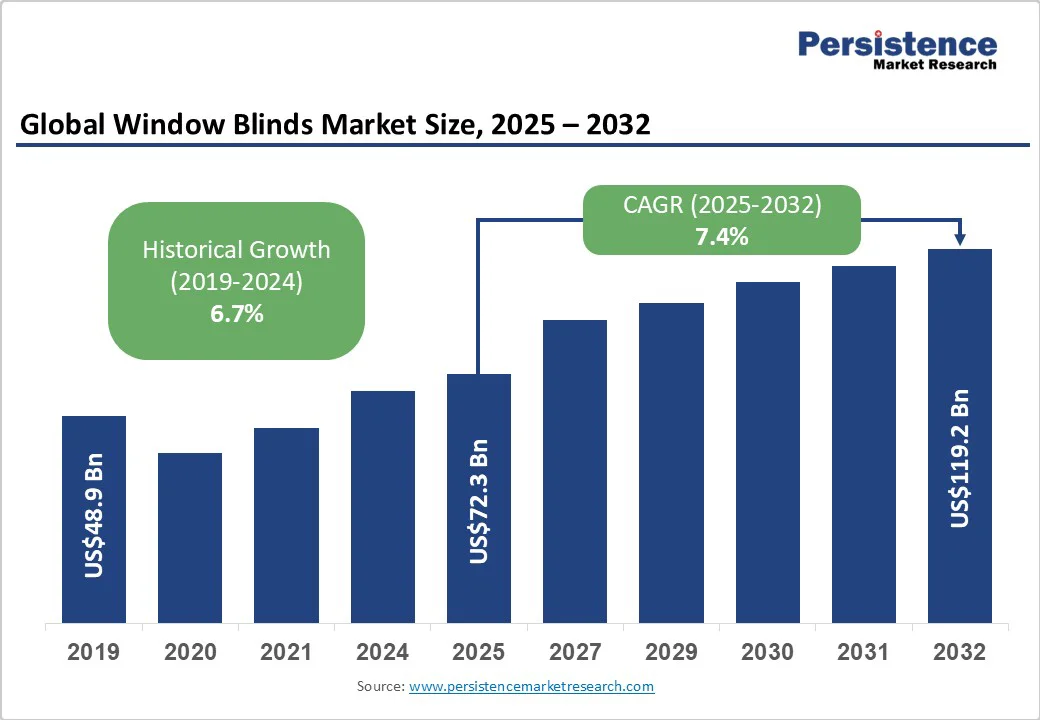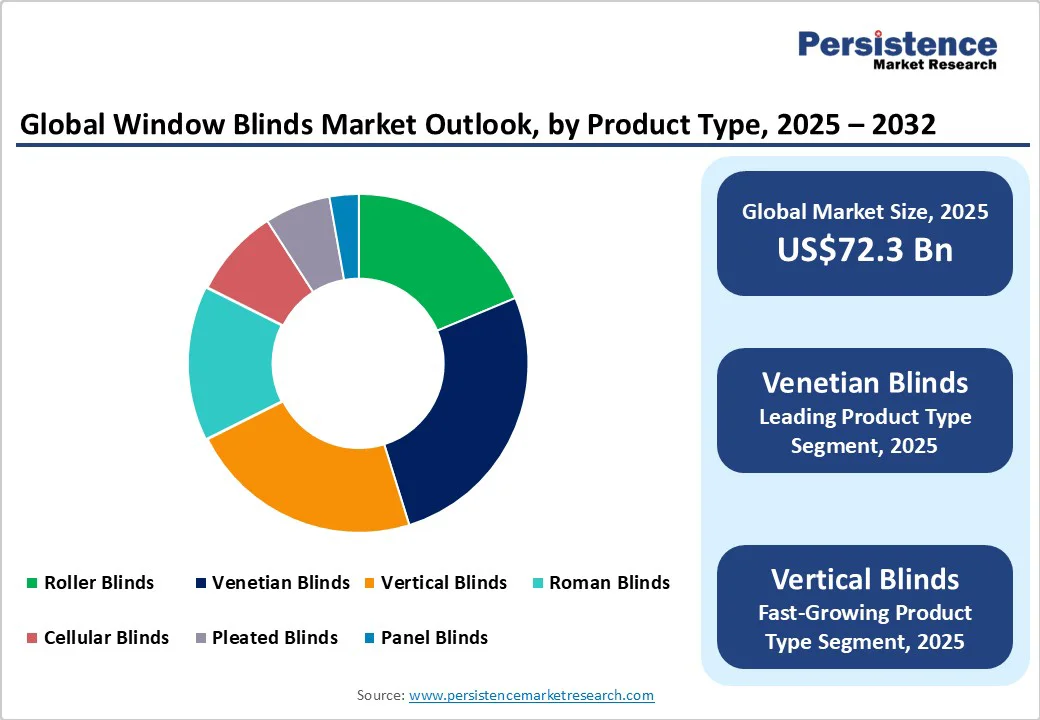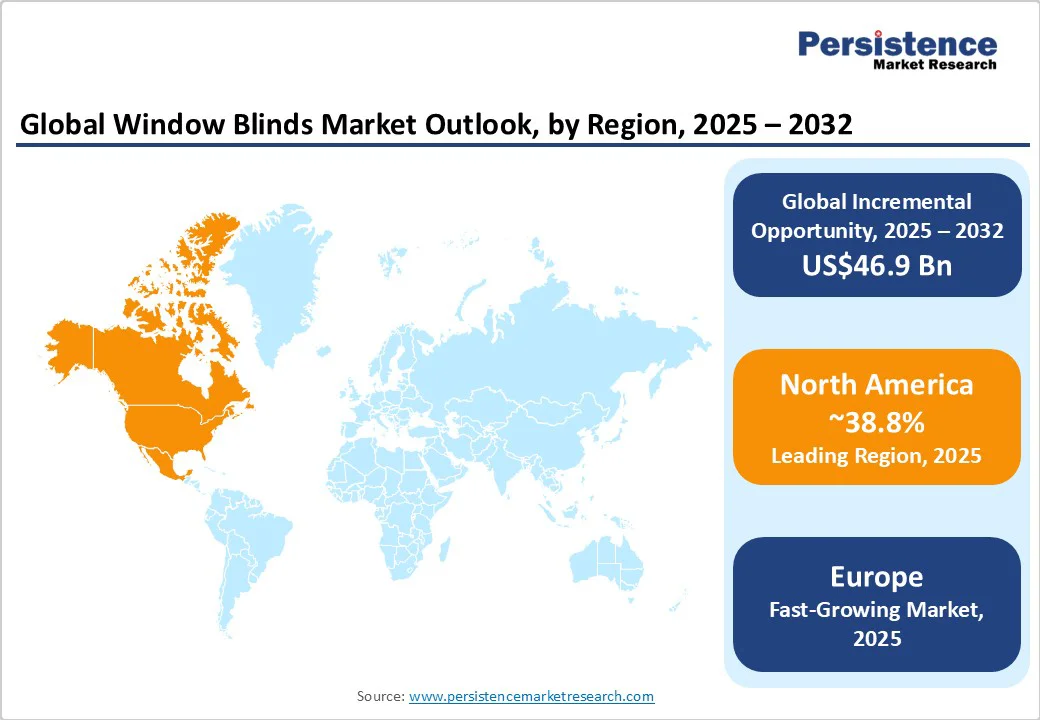ID: PMRREP25483| 189 Pages | 10 Oct 2025 | Format: PDF, Excel, PPT* | Consumer Goods

The global window blinds market size is expected to reach US$72.3 billion by 2025. It is estimated to reach US$119.2 billion by 2032, growing at a CAGR of 7.4% during the forecast period from 2025 to 2032, driven by their ability to enhance comfort, privacy, and energy efficiency in residential and commercial spaces. Precise control over natural light also enables users to adjust sunlight as per their requirements.
| Key Insights | Details |
|---|---|
|
Window Blinds Market Size (2025E) |
US$72.3 Bn |
|
Market Value Forecast (2032F) |
US$119.2 Bn |
|
Projected Growth (CAGR 2025 to 2032) |
7.4% |
|
Historical Market Growth (CAGR 2019 to 2024) |
6.7% |

A major growth driver for window blinds is their ability to control sunlight and privacy within indoor spaces precisely. Unlike curtains or shades, blinds allow users to adjust slats to let in partial light, filter glare, or block sunlight completely, making them ideal for activities such as watching TV, working from home, or sleeping during the day.
Modern designs, including Venetian and zebra blinds, provide smooth adjustment and can be motorized for effortless operation. Smart blinds integrated with apps or voice assistants further enhance convenience, enabling homeowners to schedule light adjustments automatically based on the time of day or sunlight intensity.
Another key growth driver is the role of blinds as effective insulators, helping regulate indoor temperatures. Cellular, honeycomb, and layered fabric blinds trap air between slats, reducing heat gain during summer and retaining warmth in winter.
This insulation capability directly contributes to low energy consumption and reduced utility bills, which environmentally conscious consumers value. With rising electricity costs and increasing awareness of sustainable living, the energy-saving properties of blinds make them a preferred choice for modern homes and offices.
A key restraint for window blinds is their tendency to collect dust and dirt, especially in homes or offices located in urban or industrial areas. Blinds with horizontal slats require regular cleaning to maintain hygiene and aesthetic appeal. This high-maintenance factor can deter consumers who prefer low-effort window coverings, particularly in commercial spaces or high-rise apartments.
Even fabrics with dust-resistant coatings eventually require deep cleaning, adding time and cost for users. For example, some consumers opt for roller or motorized blinds with washable fabrics to mitigate dust issues, but these solutions can be more expensive. The necessity for frequent maintenance limits adoption in markets where convenience and low upkeep are primary purchasing criteria.
Another key restraint is the safety hazard posed by exposed cords on blinds. Traditional corded blinds can create entanglement risks for young children and pets, leading to injuries or even fatalities. This concern has prompted regulatory bodies in the U.S., Europe, and Australia to recommend or mandate the use of cordless designs or cord safety devices.
While cordless and motorized options reduce these risks, they come at a high cost, which can discourage adoption among budget-conscious consumers. Brands are hence promoting cordless, smart-operated blinds; however, the widespread replacement of existing corded blinds remains a challenge, particularly in residential retrofit markets.
One of the most promising growth opportunities in the market is the integration of blinds with smart home ecosystems. Consumers seek automation that allows them to control lighting, privacy, and temperature through mobile apps or voice assistants such as Alexa, Google Home, and Apple HomeKit.
Motorized blinds that adjust according to the time of day, sunlight intensity, or user schedules are gaining popularity in urban apartments, offices, and luxury homes. For example, Somfy’s TaHoma and Lutron Serena Shades offer seamless connectivity with smart devices, enabling energy-efficient lighting management while enhancing convenience.
Another opportunity lies in the increasing demand for eco-conscious and sustainable window coverings. Consumers and commercial developers are seeking blinds made from bamboo, recycled fabrics, and low-VOC materials, which reduce environmental impact while delivering aesthetic appeal.
These materials are not only lightweight and durable but also provide natural insulation, contributing to energy efficiency in homes and offices. For instance, Luxaflex has introduced collections made from recycled fabric and FSC-certified wood to attract environmentally conscious buyers. As green building norms tighten across Europe, North America, and the Asia Pacific, the market for sustainable blinds is expected to rise steadily.
Venetian blinds are expected to account for approximately 26.5% of the market share in 2025 as they combine versatility, light control, and timeless aesthetics suitable for both residential and commercial interiors. Their adjustable horizontal slats allow users to regulate light and privacy more precisely than roller or Roman shades. Modern Venetian blinds, made from aluminum, faux wood, and PVC, deliver durability, moisture resistance, and easy maintenance, making them ideal for humid spaces like kitchens and bathrooms.
Vertical blinds continue to experience steady demand, primarily due to their practicality in covering large windows, sliding glass doors, and office partitions. Their vertical slats provide effective control of glare and heat, making them suitable for commercial buildings and modern homes with expansive glass façades. These blinds are easy to clean and maintain, an important reason for their continued preference in high-traffic environments such as hospitals, schools, and corporate spaces.
Fabric is speculated to hold a share of nearly 41.9% in 2025, as it provides design flexibility, insulation benefits, and affordability. Modern fabrics are designed for both durability and functionality. Many are UV-resistant, dust-repellent, and flame-retardant, making them suitable for both residential and commercial use. Fabric blinds come in an extensive range of textures, patterns, and opacity levels, allowing users to achieve both light filtration and privacy.
Wood will likely witness a substantial CAGR from 2025 to 2032, owing to its natural warmth, premium appeal, and excellent insulation properties. Wooden blinds improve interior aesthetics by adding a touch of craftsmanship and sophistication, especially in residential and hospitality settings. They help regulate indoor temperature effectively by blocking heat and sunlight, improving energy efficiency. Several manufacturers are now turning to FSC-certified wood and bamboo alternatives to ensure sustainability.
Healthcare is poised to hold a market share of around 33.6% in 2025, as hospitals and clinics require strict control over light, privacy, and hygiene. Blinds made from antimicrobial, dust-resistant, and easy-to-clean materials help maintain sterile environments better than traditional curtains. Automated blinds are extensively used in ICUs and patient wards to minimize touchpoints and reduce infection risks. For example, Lutron’s Serena Smart Shades and Somfy’s motorized systems are being adopted in healthcare facilities to enable remote operations and ensure patient comfort.
Education is a key end-user as schools, universities, and training centers require effective light and temperature control for improved focus and energy efficiency. Classrooms benefit from blinds that reduce glare on screens and boards while allowing natural daylight to pass through. Vertical and roller blinds made from acoustic and UV-filtering fabrics are widely used to enhance visual comfort and reduce heat gain, thereby reducing energy consumption. Multiple institutions are also integrating automated blinds with smart lighting systems to optimize energy management.

North America is expected to account for approximately 38.8% of the market share in 2025, owing to high demand for automation, energy efficiency, and sustainability. The region has seen widespread adoption of smart blinds that integrate with home automation systems, including Alexa, Google Home, and Apple HomeKit. These solutions allow users to control lighting and temperature through voice commands or mobile apps, making them popular among tech-savvy homeowners. Lutron, Somfy, and Hunter Douglas are leading this shift by delivering app-based or remote-controlled blinds designed to improve energy management and comfort.
Sustainability has also become a defining factor in North America. Consumers are opting for eco-friendly and energy-saving materials, including recycled polyester and low-VOC fabrics, which help reduce heat gain and carbon footprint. The popularity of cellular and honeycomb blinds is increasing as they offer improved insulation and contribute to more energy-efficient homes. In 2024, several retailers in Canada reported high demand for energy-rated window coverings as part of green home renovations.
In Europe, consumers and businesses are now prioritizing energy-efficient window coverings to reduce heating and cooling costs. This demand is supported by the European Union's Energy Performance of Buildings Directive (EPBD), which mandates the use of energy-efficient window coverings, promoting their widespread adoption in both new and existing buildings. Materials such as bamboo, jute, and recycled fabrics are gaining popularity for their natural aesthetics and minimal environmental impact.
The adoption of smart window blinds is on the rise, with several models now integrated into home automation platforms, allowing users to control blinds through apps, voice assistants, and smart hubs. In the U.K., for instance, 40% of homeowners prefer shading systems integrated with smart ecosystems. Companies are also providing solar-powered smart blinds, which improve sustainability and reduce electricity dependence.
The Asia Pacific is surging at a steady pace, driven by the increased construction of residential and commercial buildings. India, China, and Southeast Asia are seeing high demand as middle-class consumers and corporate buyers seek modern, functional, and aesthetically appealing window coverings. Urban housing projects and high-rise apartments are driving demand for space-efficient blinds, including roller, vertical, and Venetian types, which provide privacy, light control, and energy efficiency.
There is a rising preference for blinds over shades in the Asia Pacific, mainly since blinds are more durable, easier to clean, and suitable for humid and dusty climates. However, shades are emerging as a fast-growing segment due to developments in materials, patterns, and automation. Brands are introducing dual-layer fabrics, blackout options, and UV-protective materials, which appeal to consumers looking to combine functionality with interior design.

The global window blinds market is fragmented with a mix of established global brands and regional manufacturers competing for a high share. Companies such as Hunter Douglas, Springs Window Fashions, and Lutron Electronics dominate the premium and smart blinds segment through development in motorized and automated systems. These players focus on energy efficiency, customization, and aesthetics, while small brands compete mainly on affordability and quick delivery times.
The window blinds market is projected to reach US$72.3 Billion in 2025.
Increasing preference for privacy and surging demand for energy-saving insulation are the key market drivers.
The window blinds market is poised to witness a CAGR of 7.4% from 2025 to 2032.
Expansion in smart home integration and adoption of eco-friendly materials are the key market opportunities.
Lutron Electronics, Hunter Douglas, and Horizons Window Fashions are a few key market players.
| Report Attribute | Details |
|---|---|
|
Historical Data/Actuals |
2019 - 2024 |
|
Forecast Period |
2025 - 2032 |
|
Market Analysis |
Value: US$ Bn |
|
Geographical Coverage |
|
|
Segmental Coverage |
|
|
Competitive Analysis |
|
|
Report Highlights |
|
By Product Type
By Material
By End-user
By Region
Delivery Timelines
For more information on this report and its delivery timelines please get in touch with our sales team.
About Author